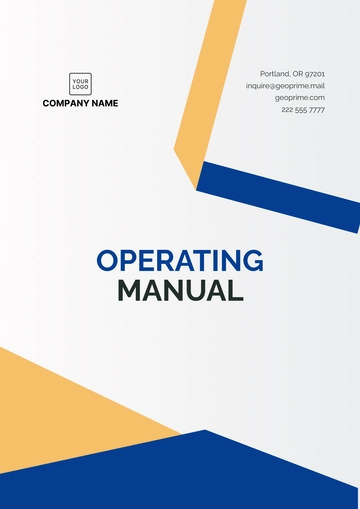Free Agriculture Environmental Education Manual

I. Introduction
The purpose of this manual is to provide a comprehensive guide to sustainable agricultural practices, emphasizing the importance of environmental education in fostering a more sustainable and resilient farming system. This manual is designed for students, teachers, and community members who are interested in understanding and implementing sustainable agriculture. By integrating environmental education with agricultural practices, [Your Company Name] aims to promote a deeper understanding of how sustainable methods can benefit both the environment and agricultural productivity.
II. Overview of Sustainable Agriculture
A. Definition and Principles
Sustainable agriculture refers to farming practices that meet current food and textile needs without compromising the ability of future generations to meet their needs. It integrates three main goals: environmental health, economic profitability, and social and economic equity.
Conservation and Preservation: Protecting natural resources by minimizing soil erosion, water usage, and deforestation.
Biodiversity: Encouraging diverse plant and animal species to promote ecological balance and resilience.
Energy Efficiency: Utilizing renewable energy sources and improving energy efficiency to reduce the carbon footprint.
Soil Health: Maintaining and enhancing soil fertility through natural means, such as crop rotation and organic amendments.
Water Management: Implementing practices that use water efficiently and protect water quality.
Animal Welfare: Ensuring ethical treatment of livestock, including providing adequate space, nutrition, and care.
Community Involvement: Engaging local communities in decision-making processes and supporting local economies.
B. Benefits
Sustainable agriculture offers numerous benefits that extend beyond the farm:
Environmental Benefits: Reduces pollution and greenhouse gas emissions. Conserves water and soil resources. Enhances biodiversity and ecosystem health.
Economic Benefits: Lowers input costs by reducing reliance on synthetic chemicals and fossil fuels. Increases farm resilience and productivity. Opens new market opportunities for sustainably produced products.
Social Benefits: Improves food security and nutrition. Supports rural development and community well-being. Promotes fair labor practices and equitable access to resources.
III. Understanding Ecosystems
A. Basic Ecology
An ecosystem is a community of living organisms interacting with their physical environment. It includes plants, animals, microorganisms, water, soil, and air. Ecosystems function through nutrient cycles and energy flows, which sustain life by recycling essential elements and providing energy for organisms.
Ecosystems are characterized by biodiversity, which is the variety of life forms within them. High biodiversity increases resilience against environmental changes and disturbances, ensuring ecosystem stability and productivity. Biodiversity includes genetic diversity within species, species diversity within communities, and ecosystem diversity across landscapes.
Healthy ecosystems provide numerous ecosystem services that benefit humanity, such as clean air and water, pollination of crops, climate regulation, and recreational opportunities. The balance and health of ecosystems are crucial for sustaining these services and supporting life on Earth.
B. Agricultural Ecosystems
Agricultural ecosystems, or agroecosystems, are managed environments where crops and livestock are cultivated. Unlike natural ecosystems, agroecosystems are designed to maximize agricultural output, often involving human interventions such as plowing, irrigation, and fertilization.
Agroecosystems can vary widely in their composition and management practices. Sustainable agroecosystems aim to mimic natural processes, enhancing soil health, biodiversity, and resource efficiency. Integrating sustainable practices into agroecosystems helps maintain ecological balance while providing agricultural benefits.
C. Impact of Agriculture on Ecosystems
Agricultural practices can have profound impacts on ecosystems, both positive and negative. Understanding these impacts is essential for developing sustainable farming methods.
Negative Impacts
Deforestation: Clearing forests for agriculture reduces biodiversity and disrupts ecosystems.
Soil Degradation: Intensive farming can lead to soil erosion, nutrient depletion, and loss of organic matter.
Water Pollution: Runoff from fertilizers and pesticides can contaminate water sources, harming aquatic life.
Greenhouse Gas Emissions: Agriculture contributes to climate change through methane emissions from livestock and carbon dioxide from machinery.
Habitat Loss: Expanding agricultural land can lead to loss of natural habitats and decline in wildlife populations.
Positive Impacts
Biodiversity Enhancement: Incorporating diverse crops and natural habitats can support wildlife and pollinators.
Soil Health Improvement: Practices like cover cropping and composting enhance soil fertility and structure.
Water Conservation: Efficient irrigation and rainwater harvesting reduce water usage and protect water resources.
Carbon Sequestration: Agroforestry and no-till farming can capture carbon in soil and vegetation, mitigating climate change.
By adopting sustainable agricultural practices, we can minimize the negative impacts and enhance the positive effects on ecosystems, contributing to a healthier environment and more resilient agricultural systems.
IV. Soil Health and Management
A. Soil Composition and Function
Soil is a complex mixture of minerals, organic matter, water, air, and living organisms. The composition of soil varies greatly depending on factors such as climate, vegetation, and topography. Soil minerals originate from the weathering of rocks and are classified into sand, silt, and clay particles. Organic matter in the soil includes decomposed plant and animal residues, which contribute to soil fertility and structure. The pore spaces in soil hold water and air, essential for plant growth and microbial activity.
Soil functions as the foundation for plant growth by providing nutrients, water, and support for roots. It also acts as a filtration system for water, removing impurities and regulating water flow. Soil biodiversity, including bacteria, fungi, earthworms, and other organisms, plays a critical role in nutrient cycling, organic matter decomposition, and soil structure maintenance. Healthy soil is vital for sustainable agriculture as it enhances crop productivity and resilience against environmental stressors.
B. Soil Conservation Techniques
Maintaining and improving soil health is crucial for sustainable agriculture. Several soil conservation techniques can help protect and enhance soil quality:
Crop Rotation: Growing different crops in succession on the same land to improve soil fertility and reduce pest and disease buildup.
Cover Cropping: Planting cover crops, such as legumes or grasses, during off-seasons to prevent soil erosion, improve soil structure, and enhance nutrient cycling.
Conservation Tillage: Reducing the frequency and intensity of tillage to minimize soil disturbance, maintain soil structure, and reduce erosion.
Composting: Adding decomposed organic matter to soil to improve its structure, nutrient content, and microbial activity.
Agroforestry: Integrating trees and shrubs into agricultural systems to improve soil fertility, reduce erosion, and enhance biodiversity.
C. Erosion Control
Soil erosion is a major challenge in agriculture, leading to loss of topsoil, reduced soil fertility, and water pollution. Effective erosion control strategies are essential for sustainable land management:
Contour Plowing: Plowing along the contours of the land to reduce runoff and soil erosion.
Terracing: Creating stepped levels on slopes to slow water flow and reduce soil erosion.
Strip Cropping: Alternating strips of different crops to reduce soil erosion and enhance soil fertility.
Grassed Waterways: Planting grass in drainage channels to prevent soil erosion and filter runoff.
Windbreaks: Planting trees or shrubs in rows to reduce wind speed and protect soil from wind erosion.
V. Water Management
A. Water Cycle and Agriculture
The water cycle is a continuous process involving the movement of water from the Earth's surface to the atmosphere and back. It includes processes such as evaporation, transpiration, condensation, precipitation, and infiltration. In agriculture, understanding the water cycle is crucial for efficient water management and ensuring sustainable crop production. Water is essential for plant growth, influencing processes such as photosynthesis, nutrient uptake, and temperature regulation.
Agricultural practices can impact the water cycle through irrigation, drainage, and land use changes. Efficient water management in agriculture aims to optimize water use, reduce waste, and protect water quality. By aligning farming practices with the natural water cycle, we can enhance water availability for crops and minimize the environmental impact of agriculture.
B. Efficient Water Use
Efficient water use is vital for sustainable agriculture, ensuring that water resources are used effectively to support crop growth while conserving water. Several methods can improve water use efficiency:
Drip Irrigation: Delivering water directly to the root zone of plants through a network of tubes and emitters, reducing water waste and evaporation.
Rainwater Harvesting: Collecting and storing rainwater for irrigation and other agricultural uses, reducing dependence on groundwater and surface water sources.
Mulching: Applying a layer of organic or inorganic material on the soil surface to reduce evaporation, retain soil moisture, and suppress weeds.
Scheduling Irrigation: Timing irrigation based on crop water needs, weather conditions, and soil moisture levels to optimize water use.
Soil Moisture Monitoring: Using sensors and tools to measure soil moisture levels and adjust irrigation accordingly.
C. Water Quality Protection
Protecting water quality is essential for sustainable agriculture and environmental health. Several practices can help prevent water contamination and maintain water quality:
Buffer Strips: Planting strips of vegetation along waterways to filter runoff and reduce nutrient and pesticide contamination.
Nutrient Management: Applying fertilizers based on soil testing and crop needs to minimize nutrient runoff and leaching.
Integrated Pest Management: Reducing pesticide use and using targeted, environmentally friendly pest control methods to prevent water pollution.
Cover Crops: Planting cover crops to reduce soil erosion, nutrient runoff, and improve soil structure.
Constructed Wetlands: Creating wetlands to treat agricultural runoff, filter pollutants, and enhance biodiversity.
VI. Crop Management
A. Crop Diversity
Crop diversity refers to the variety of crops grown within an agricultural system. It is a key component of sustainable agriculture, offering numerous ecological, economic, and social benefits. Diversified cropping systems can enhance soil health, reduce pest and disease pressures, and increase resilience against environmental stressors such as climate change and extreme weather events. By growing a range of crops, farmers can improve their income stability and reduce the risk of crop failure.
Crop diversity can be achieved through practices such as crop rotation, intercropping, and agroforestry. Crop rotation involves growing different crops in succession on the same land, which helps break pest and disease cycles and improves soil fertility. Intercropping involves growing two or more crops simultaneously on the same field, promoting beneficial interactions between crops and optimizing resource use. Agroforestry integrates trees and shrubs into agricultural systems, enhancing biodiversity, soil health, and water management.
B. Integrated Pest Management
Integrated Pest Management (IPM) is a sustainable approach to pest control that combines biological, cultural, mechanical, and chemical methods to manage pest populations while minimizing environmental impact. IPM emphasizes prevention, monitoring, and targeted control strategies:
Biological Control: Using natural predators, parasites, or pathogens to control pest populations.
Cultural Practices: Implementing farming practices such as crop rotation, intercropping, and sanitation to reduce pest habitats and food sources.
Mechanical Control: Using physical methods such as traps, barriers, and manual removal to manage pests.
Chemical Control: Applying pesticides selectively and only when necessary, using the least toxic options and following proper application guidelines.
Monitoring and Scouting: Regularly inspecting crops for pest presence and damage to inform timely and targeted control measures.
C. Organic Farming
Organic farming is a holistic approach to agriculture that emphasizes the use of natural inputs and processes to produce food sustainably. It focuses on enhancing soil health, promoting biodiversity, and avoiding synthetic chemicals. Key practices in organic farming include:
Organic Fertilization: Using compost, manure, and green manures to improve soil fertility and organic matter content.
Pest and Disease Management: Implementing IPM strategies, including biological control, crop rotation, and resistant varieties, to manage pests and diseases without synthetic pesticides.
Weed Control: Using mechanical methods, cover crops, and mulching to control weeds without synthetic herbicides.
Soil Health Improvement: Employing practices such as cover cropping, crop rotation, and reduced tillage to enhance soil structure, fertility, and microbial activity.
Animal Welfare: Ensuring humane and ethical treatment of livestock, including providing access to pasture, organic feed, and proper healthcare.
VII. Livestock Management
A. Sustainable Livestock Practices
Sustainable livestock practices involve managing animals in ways that enhance the well-being of the environment, the animals, and the farmers. These practices emphasize the importance of maintaining the health of the land, water, and air, while ensuring that the animals are raised humanely. Key strategies include rotational grazing, which allows pastures to recover and prevents overgrazing, and integrated livestock-crop systems, where livestock waste is used as fertilizer for crops, creating a closed-loop system that minimizes waste and improves soil fertility.
Furthermore, sustainable livestock practices also incorporate the use of natural feed and the avoidance of synthetic hormones and antibiotics. By feeding animals a diet that mimics their natural food sources, farmers can improve the health and productivity of their livestock. Additionally, reducing the use of antibiotics and hormones helps to prevent the development of antibiotic-resistant bacteria and maintains the integrity of meat and dairy products for consumers.
B. Pasture Management
Effective pasture management is crucial for maintaining healthy grasslands and ensuring the sustainability of livestock farming. This involves careful planning and monitoring of grazing patterns to prevent overgrazing, soil erosion, and degradation of the pasture. One common practice is rotational grazing, where livestock are moved between different pasture areas to allow vegetation in previously grazed areas to recover. This not only maintains pasture productivity but also enhances biodiversity and soil health.
In addition to rotational grazing, farmers can implement pasture improvement techniques such as reseeding with a mix of grasses and legumes, which can improve the nutritional quality of the forage and fix nitrogen in the soil, reducing the need for synthetic fertilizers. Maintaining healthy pastures also involves managing water resources, ensuring that livestock have access to clean water while protecting natural waterways from contamination by livestock waste.
C. Animal Health and Welfare
Ensuring animal health and welfare is a cornerstone of sustainable livestock management. This involves providing animals with adequate space, nutritious feed, clean water, and appropriate shelter to meet their physical and behavioral needs. Practices such as regular health checks, vaccination programs, and humane handling techniques are essential to prevent disease and stress among livestock, leading to improved productivity and quality of animal products.
Additionally, animal welfare extends beyond physical health to include mental well-being. Providing an environment that allows animals to express natural behaviors, such as grazing, rooting, or dust-bathing, contributes to their overall welfare. Farmers can achieve this by designing living spaces that mimic natural habitats and by using low-stress handling techniques to minimize fear and anxiety during interactions with humans.
VIII. Renewable Energy in Agriculture
A. Types of Renewable Energy
There are different types of renewable energy that can be maximized to make agriculture sustainable:
Solar Energy: Harnessing sunlight through photovoltaic panels to generate electricity for farm operations, such as irrigation systems, lighting, and heating.
Wind Energy: Using wind turbines to convert wind energy into electricity, which can power various agricultural equipment and reduce reliance on fossil fuels.
Bioenergy: Producing energy from organic materials, such as crop residues, animal manure, and dedicated energy crops, through processes like anaerobic digestion and fermentation.
Hydropower: Utilizing small-scale water turbines in streams or rivers to generate electricity for farm use, particularly in areas with sufficient water flow.
B. Benefits of Renewable Energy
Integrating renewable energy into agriculture offers numerous benefits that contribute to sustainability and resilience:
Environmental Benefits: Reduces greenhouse gas emissions and mitigates climate change. Decreases dependence on non-renewable energy sources. Minimizes pollution and improves air and water quality.
Economic Benefits: Lowers energy costs and increases energy independence. Provides opportunities for additional income through the sale of excess energy. Enhances the long-term viability of agricultural operations.
Social Benefits: Promotes rural development and job creation in renewable energy sectors. Improves energy access and reliability for remote and underserved communities. Encourages sustainable practices and environmental stewardship.
C. Implementation Strategies
To successfully implement renewable energy in agriculture, farmers can adopt several strategies.
Firstly, conducting an energy audit can help identify the most suitable renewable energy sources based on the farm's location, energy needs, and resources.
Secondly, leveraging government incentives, grants, and subsidies can reduce the financial burden of installing renewable energy systems.
Thirdly, collaborating with renewable energy providers and experts can ensure the optimal design and installation of energy systems, maximizing efficiency and return on investment.
Lastly, integrating renewable energy with energy-efficient practices, such as upgrading to energy-efficient equipment and optimizing energy use, can further enhance the sustainability of agricultural operations.
IX. Success Story
In a rural farming community, a family farm faced significant challenges due to unpredictable weather patterns and rising energy costs. Determined to improve the sustainability and resilience of their farm, they decided to invest in renewable energy solutions. They began by installing a solar panel system to power their irrigation pumps and barn lighting. This initial investment not only reduced their energy bills but also provided a reliable source of power during peak farming seasons.
Encouraged by the success of their solar energy project, the farm expanded their renewable energy portfolio by incorporating wind turbines. The wind turbines generated additional electricity, which they used to power their grain drying operations and electric fencing. The combination of solar and wind energy enabled the farm to become nearly self-sufficient in terms of energy, significantly lowering their operational costs and reducing their carbon footprint.
Moreover, the farm adopted sustainable livestock practices, including rotational grazing and organic feed. These practices improved soil health, increased pasture productivity, and enhanced animal welfare. The integration of renewable energy and sustainable farming practices transformed the farm into a model of environmental stewardship and economic resilience. The farm's success inspired neighboring farmers to explore renewable energy options, fostering a community-wide movement towards sustainable agriculture.
X. Resources
A. Books and Articles
"Sustainable Agriculture" by John Smith
"The Soil Will Save Us" by Kristin Ohlson
"Farming with Nature" by Sara Scherr and Jeffrey McNeely
B. Websites and Online Courses
Sustainable Agriculture Research & Education (SARE) program
Organic Farming Research Foundation
Coursera's Sustainable Agricultural Land Management course
C. Organizations and Networks
Food and Agriculture Organization (FAO)
National Sustainable Agriculture Coalition (NSAC)
International Federation of Organic Agriculture Movements (IFOAM)
- 100% Customizable, free editor
- Access 1 Million+ Templates, photo’s & graphics
- Download or share as a template
- Click and replace photos, graphics, text, backgrounds
- Resize, crop, AI write & more
- Access advanced editor
Discover Template.net's Agriculture Environmental Education Manual Template, completely editable and customizable in our AI Editor tool. Ideal for creating comprehensive manuals that educate on environmental practices in agriculture. Perfect for organizations promoting sustainable farming and environmental stewardship.





























